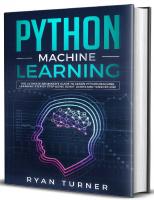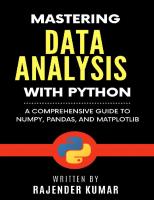Mastering OpenCV with Python: Use NumPy, Scikit, TensorFlow, and Matplotlib to learn Advanced algorithms for Machine Learning through a set of Practical Projects 9789390475797
Unlocking Visual Insights: OpenCV Made Simple and Powerful. Key Features ● OpenCV Mastery: Harness the full potential o
114 73 11MB
English Pages 423 Year 2023
Table of contents :
Cover Page
Title Page
Copyright Page
Dedication Page
About the Author
About the Technical Reviewer
Acknowledgements
Preface
Errata
Table of Contents
1. Introduction to Computer Vision
Introduction
Structure
Introduction to Computer Vision
Applications of Computer Vision
Python
OpenCV.
Brief history of OpenCV
OpenCV 4.7
Supporting Libraries
NumPy
Matplotlib
SciPy
Scikit-Learn
Scikit-Image
Mahotas
TensorFlow
Keras
Dlib
Environment Setup
Installing Python
Installing Python on Windows
Installing Python on Ubuntu and Mac
Package Manager
Installing libraries
Installing Mahotas
Installing OpenCV
Verifying our installation
IDE
Documentation
Conclusion
Test Your Understanding
2. Getting Started with Images
Structure
Introduction to images and pixels
Loading and displaying images
Imread()
Imshow
Imwrite
WaitKey
DestroyAllWindows
Manipulating images with pixels
Accessing individual pixels
Accessing a region of interest (ROI)
Drawing in OpenCV
Line
Rectangle
Circle
Text
Conclusion
Points to remember
Test your understanding
3. Image Processing Fundamentals
Structure
Geometric transformations
Image translation
Rotation
Scaling
Flipping
Shearing
Cropping
Arithmetic Operations
Addition
Subtraction
Multiplication and division
Bitwise operations
AND
OR
XOR
NOT
Channels and color spaces
Red Green Blue (RGB) color space
Blue Green Red (BGR) color space
Hue Saturation Value (HSV) color space
Hue Saturation Lightness (HSL) color space
cvtColor() 67 Hue Saturation Lightness (HSL) color space
LAB color space
YCbCr color space
Conclusion
Points to Remember
Test Your Understanding
4. Image Operations
Structure
Morphological operations on images
Erosion
cv2.Erode()
Dilation
cv2.Dilate()
Opening
Cv2.morphologyex()
Closing
Morphological gradient
Top hat
Bottom hat
Smoothing and blurring
Average blurring
Cv2.blur()
Median blur
cv2.medianBlur()
Gaussian blur
cv2.gaussianBlur()
Bilateral filter
cv2.bilateralFilter()
Conclusion
Points to remember
Test your understanding
5. Image Histograms
Structure
Introduction to histograms
cv2.calcHist()
Matplotlib helper functions
Histogram for colored images
Two-dimensional histograms
Histogram with masks
Histogram equalization
cv2.equalizeHist()
Histogram equalization on colored images
Adaptive histogram equalization
Contrast limited adaptive histogram equalization (CLAHE)
cv2.createCLAHE()
Histograms for feature extraction
Conclusion
Points to remember
Test your understanding
6. Image Segmentation
Structure
Introduction to Image Segmentation
Basic Segmentation Techniques
Image thresholding
Simple Thresholding
cv2.threshold()
Adaptive Thresholding
cv2.adaptiveThreshold()
Otsu’s Thresholding
Edge and contour-based segmentation
Advanced Segmentation Techniques
Watershed Algorithm
GrabCut algorithm
cv2.grabCut()
Clustering-based Segmentation
Deep Learning-based Segmentation
Conclusion
Points to Remember
Test your understanding
7. Edges and Contours
Structure
Introduction to edges
Image gradients
Filters for image gradients
Sobel Filters
cv2.Sobel()
Scharr Operator
cv2.filter2D
Laplacian Operators
Canny Edge Detector
cv2.Canny()
Introduction to Contours
Contour Hierarchy
Extracting and Visualizing Contours
cv2.findContours()
cv2.drawContours()
Contour Moments
cv2.Moments()
Properties of Contours
Area
cv2.contourArea()
Perimeter
Centroid/Center Of mass
Bounding Rectangle
cv2.boundingRect()
cv2.minAreaRect()
cv2.boxPoints()
Extent
Convex Hull
cv2.convexHull()
cv2.polyLines()
Solidity
Contour Approximation
cv2.approxPolyDP()
Contour Filtering and Selection
Conclusion
Points to Remember
Test your understanding
8. Machine Learning with Images
Structure
Introduction to Machine Learning
Overfitting and Underfitting
Evaluation Metrics
Hyperparameters and Tuning
KMeans Clustering
cv2.kmeans()
k-Nearest Neighbors (k-NN)
Feature Scaling
Hyperparameters
Logistic Regression
Hyperparameters
Decision Trees
Hyperparameters
Ensemble Learning
Random Forest
Randomness
Hyperparameters
Support Vector Machines
Conclusion
Points to Remember
Test your understanding
9. Advanced Computer Vision Algorithms
Structure
FAST (Features from Accelerated Segment Test)
cv2.FastFeatureDetector_create
Harris Keypoint Detection
cv2.cornerHarris
BRIEF (Binary Robust Independent Elementary Features)
cv2.ORB_create
ORB (Oriented FAST and Rotated BRIEF)
SIFT (Scale-Invariant Feature Transform)
cv2.SIFT_create
RootSIFT (Root Scale-Invariant Feature Transform)
SURF (Speeded-Up Robust Features)
Local Binary Patterns
Histogram of Oriented Gradients
Conclusion
Points to Remember
Test Your Understanding
10. Neural Networks
Structure
Introduction to Neural Networks
Design of a Neural Network
Activation Functions
Training a Neural Network
Gradient descent
Convolutional neural networks
Layers in a CNN
Convolutional Layer
Pooling Layer
Fully Connected Layer
Activation Layer
First Neural Network Model
Data Loading
Model Instantiation
Results
Dropout Regularization
Neural network architectures
LeNet
AlexNet
VGGNET
Transfer Learning
Other Network Architectures
GoogleNet
Inception Module
Architecture
ResNet
Conclusion
Points to remember
Test your understanding
11. Object Detection Using OpenCV
Structure
Introduction to object detection
Detecting objects using sliding windows
Template matching using OpenCV
cv2.matchTemplate
Haar cascades
Feature extraction for object detection
Image pyramids
Facial landmarks with DLIB
Object tracking using OpenCV
Conclusion
Points to remember
Test your understanding
12.Projects Using OpenCV
Structure
Automated book inventory system
Document scanning using OpenCV and OCR
Face recognition
Drowsiness detection
Conclusion
Index
Cover Page
Title Page
Copyright Page
Dedication Page
About the Author
About the Technical Reviewer
Acknowledgements
Preface
Errata
Table of Contents
1. Introduction to Computer Vision
Introduction
Structure
Introduction to Computer Vision
Applications of Computer Vision
Python
OpenCV.
Brief history of OpenCV
OpenCV 4.7
Supporting Libraries
NumPy
Matplotlib
SciPy
Scikit-Learn
Scikit-Image
Mahotas
TensorFlow
Keras
Dlib
Environment Setup
Installing Python
Installing Python on Windows
Installing Python on Ubuntu and Mac
Package Manager
Installing libraries
Installing Mahotas
Installing OpenCV
Verifying our installation
IDE
Documentation
Conclusion
Test Your Understanding
2. Getting Started with Images
Structure
Introduction to images and pixels
Loading and displaying images
Imread()
Imshow
Imwrite
WaitKey
DestroyAllWindows
Manipulating images with pixels
Accessing individual pixels
Accessing a region of interest (ROI)
Drawing in OpenCV
Line
Rectangle
Circle
Text
Conclusion
Points to remember
Test your understanding
3. Image Processing Fundamentals
Structure
Geometric transformations
Image translation
Rotation
Scaling
Flipping
Shearing
Cropping
Arithmetic Operations
Addition
Subtraction
Multiplication and division
Bitwise operations
AND
OR
XOR
NOT
Channels and color spaces
Red Green Blue (RGB) color space
Blue Green Red (BGR) color space
Hue Saturation Value (HSV) color space
Hue Saturation Lightness (HSL) color space
cvtColor() 67 Hue Saturation Lightness (HSL) color space
LAB color space
YCbCr color space
Conclusion
Points to Remember
Test Your Understanding
4. Image Operations
Structure
Morphological operations on images
Erosion
cv2.Erode()
Dilation
cv2.Dilate()
Opening
Cv2.morphologyex()
Closing
Morphological gradient
Top hat
Bottom hat
Smoothing and blurring
Average blurring
Cv2.blur()
Median blur
cv2.medianBlur()
Gaussian blur
cv2.gaussianBlur()
Bilateral filter
cv2.bilateralFilter()
Conclusion
Points to remember
Test your understanding
5. Image Histograms
Structure
Introduction to histograms
cv2.calcHist()
Matplotlib helper functions
Histogram for colored images
Two-dimensional histograms
Histogram with masks
Histogram equalization
cv2.equalizeHist()
Histogram equalization on colored images
Adaptive histogram equalization
Contrast limited adaptive histogram equalization (CLAHE)
cv2.createCLAHE()
Histograms for feature extraction
Conclusion
Points to remember
Test your understanding
6. Image Segmentation
Structure
Introduction to Image Segmentation
Basic Segmentation Techniques
Image thresholding
Simple Thresholding
cv2.threshold()
Adaptive Thresholding
cv2.adaptiveThreshold()
Otsu’s Thresholding
Edge and contour-based segmentation
Advanced Segmentation Techniques
Watershed Algorithm
GrabCut algorithm
cv2.grabCut()
Clustering-based Segmentation
Deep Learning-based Segmentation
Conclusion
Points to Remember
Test your understanding
7. Edges and Contours
Structure
Introduction to edges
Image gradients
Filters for image gradients
Sobel Filters
cv2.Sobel()
Scharr Operator
cv2.filter2D
Laplacian Operators
Canny Edge Detector
cv2.Canny()
Introduction to Contours
Contour Hierarchy
Extracting and Visualizing Contours
cv2.findContours()
cv2.drawContours()
Contour Moments
cv2.Moments()
Properties of Contours
Area
cv2.contourArea()
Perimeter
Centroid/Center Of mass
Bounding Rectangle
cv2.boundingRect()
cv2.minAreaRect()
cv2.boxPoints()
Extent
Convex Hull
cv2.convexHull()
cv2.polyLines()
Solidity
Contour Approximation
cv2.approxPolyDP()
Contour Filtering and Selection
Conclusion
Points to Remember
Test your understanding
8. Machine Learning with Images
Structure
Introduction to Machine Learning
Overfitting and Underfitting
Evaluation Metrics
Hyperparameters and Tuning
KMeans Clustering
cv2.kmeans()
k-Nearest Neighbors (k-NN)
Feature Scaling
Hyperparameters
Logistic Regression
Hyperparameters
Decision Trees
Hyperparameters
Ensemble Learning
Random Forest
Randomness
Hyperparameters
Support Vector Machines
Conclusion
Points to Remember
Test your understanding
9. Advanced Computer Vision Algorithms
Structure
FAST (Features from Accelerated Segment Test)
cv2.FastFeatureDetector_create
Harris Keypoint Detection
cv2.cornerHarris
BRIEF (Binary Robust Independent Elementary Features)
cv2.ORB_create
ORB (Oriented FAST and Rotated BRIEF)
SIFT (Scale-Invariant Feature Transform)
cv2.SIFT_create
RootSIFT (Root Scale-Invariant Feature Transform)
SURF (Speeded-Up Robust Features)
Local Binary Patterns
Histogram of Oriented Gradients
Conclusion
Points to Remember
Test Your Understanding
10. Neural Networks
Structure
Introduction to Neural Networks
Design of a Neural Network
Activation Functions
Training a Neural Network
Gradient descent
Convolutional neural networks
Layers in a CNN
Convolutional Layer
Pooling Layer
Fully Connected Layer
Activation Layer
First Neural Network Model
Data Loading
Model Instantiation
Results
Dropout Regularization
Neural network architectures
LeNet
AlexNet
VGGNET
Transfer Learning
Other Network Architectures
GoogleNet
Inception Module
Architecture
ResNet
Conclusion
Points to remember
Test your understanding
11. Object Detection Using OpenCV
Structure
Introduction to object detection
Detecting objects using sliding windows
Template matching using OpenCV
cv2.matchTemplate
Haar cascades
Feature extraction for object detection
Image pyramids
Facial landmarks with DLIB
Object tracking using OpenCV
Conclusion
Points to remember
Test your understanding
12.Projects Using OpenCV
Structure
Automated book inventory system
Document scanning using OpenCV and OCR
Face recognition
Drowsiness detection
Conclusion
Index

- Author / Uploaded
- Ayush Vaishya
- Similar Topics
- Computers
- Algorithms and Data Structures: Image Processing









![Building Machine Learning Systems with Python: Explore machine learning and deep learning techniques for building intelligent systems using scikit-learn and TensorFlow [3 ed.]
9781788623223, 1788623223](https://ebin.pub/img/200x200/building-machine-learning-systems-with-python-explore-machine-learning-and-deep-learning-techniques-for-building-intelligent-systems-using-scikit-learn-and-tensorflow-3nbsped-9781788623223-1788623223.jpg)